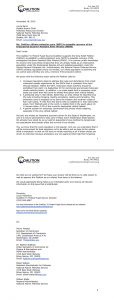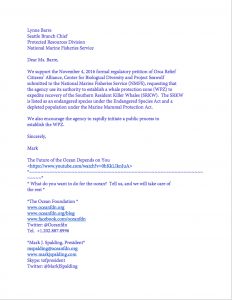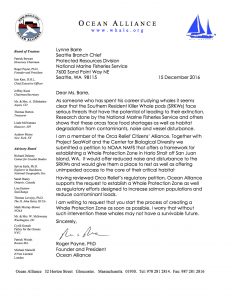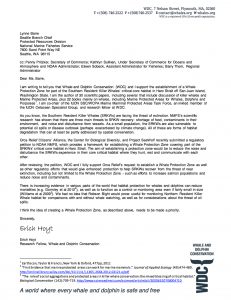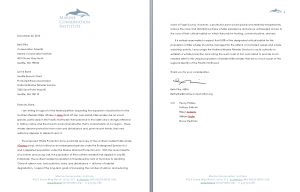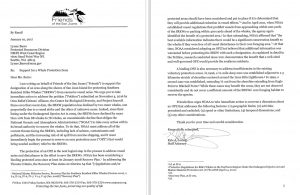The Center for Biological Diversity and Project SeaWolf joined Orca Relief Citizens’ Alliance in presenting the Whale Protection Zone proposal to NOAA. A number of other serious and respected individuals / organizations have already written letters to NOAA in support of our proposal. They include:
The Coalition to Protect Puget Sound ~~~
To download PDF click here: Coalition-Support Letter Nov 17 2016
coalitiontoprotectpugetsound.org
The Ocean Foundation ~~~
To download PDF click here: Ocean-Foundation-Support-Letter-Nov 22 2016
www.oceanfdn.org
Sea Shepherd Conservation Society ~~~
To download PDF click here: Sea Shepherd-Support-Letter- Nov 27 2016
www.seashepherd.org
Oceanic Preservation Society ~~~
To download PDF click here: OPS – Support-Letter- Dec 2 2016 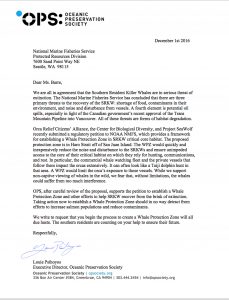
www.opsociety.org
Ocean Alliance ~~~
To download PDF click here:
Ocean Alliance- Support-Letter Dec 16 2016
www.whale.org
Sonar ~~~ To download PDF click here: Sonar- Support- Letter Dec 15 2016 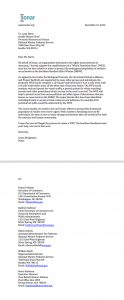
www.wearesonar.org
Whale and Dolphin Conservation ~~~
To download PDF click here: WDC-Support-Letter Dec 19 2016
us.whales.org
RE Sources for Sustainable Communities ~~~
To download PDF click here: Resources for Sustainable Communities – Support-Letter Dec 19 2016 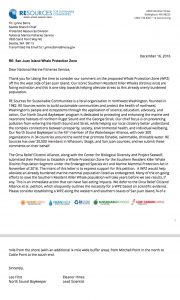
www.re-sources.org
Marine Conservation Institute ~~~
To download PDF click here: MCI -Support-Letter Dec 23 2016
marine-conservation.org
Stand.Earth ~~~
To download PDF click here: Stand.Earth-Support- Letter Jan 13 2017 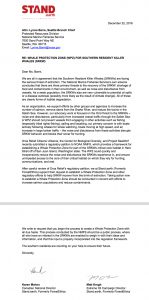
www.stand.earth
To download the PDF click here: Friends of the San Juans
http://sanjuans.org
MMC Comments on Petition to Establish Whale Protection Zone for SRKWs
MRC recomendation to Council on SRKW petition
SeaDoc_comments_for_NOAA_on_SRKW_No-go_zone_April_10,_2017
Raincost Conservation Foundation- Letter of Support
_______________________________________________________________________________
Coalition of Groups for an Orca Protection Zone
We, the undersigned organizations, call upon the National Marine Fisheries Service to rapidly begin the regulatory process needed to establish a Whale Protection Zone on the West Side of San Juan Island, Washington.
More than three years ago, April 14, 2011, the National Marine Fisheries Service (NMFS) established regulations under the Endangered Species Act and Marine Mammal Protection Act that were intended to protect the Southern Resident Orca whales from vessel impacts in the Salish Sea.[i] While those regulations established a 200 yard separation from individual whales, and proscribed ‘parking in the path’ of the whales,[ii] they did not include the originally proposed Whale Protection Zone (WPZ) on the west side of San Juan Island. (The 2011 regulations were not intended to address other factors that NMFS had found as threats to the survival of the Orca, decreasing food sources, toxic water pollution, and oil spills.[iii])
As part of its recovery planning for these endangered top predators of Puget Sound, NMFS has established recovery targets of 113 members by 2015 and 155 members by 2029 (an increase of 2.3% per year).[iv]
Despite these targets and new regulations, the Southern Resident Orca remain endangered and are declining, rather than recovering, with the most recent census count of just 78 members (for J, K, and L Pods combined). This is the lowest number since 1985[v] the Orca are no better off now than three decades ago.
Over a decade of research by NMFS and other scientists has determined that the Southern Resident Orcas are harmed by a dangerous ladder of factors:
- In years of low Chinook salmon returns, SRKWs are under stress to find food;
- Constant pursuit by vessels that include the commercial motorized whale watching fleet leads to increased stress levels, increased metabolic rates and an increased need for food, while simultaneously reducing their sonar and therefore hunting efficiency. This is happening during daylight hours from May to October; and then
- As whales starve, they consume the toxins locked in their blubber reserves.
Unfortunately, in the newly established regulations, NMFS did not include the geographic Whale Protection Zone the agency originally proposed. A WPZ on the west side of San Juan Island is a key missing piece of regulatory protection that will give the best chance of saving the Orca population from extinction.
Therefore, to prevent further harm and to begin the recovery of this endangered species, we, the undersigned organizations, call upon NMFS to rapidly begin the regulatory process needed to establish a Whale Protection Zone on the West Side of San Juan Island, Washington. Together, the Coalition will work with NMFS and other interested parties to determine the best approach to design, management, and enforcement of the West Side Whale Protection Zone.
If your organization is interested in joining the following groups in support of a Whale Protection Zone, please contact Executive Director Scott West at scottwest@orcarelief.org or call him at 425-299-8727 for more details.
Orca Relief Citizens’ Alliance, Friday Harbor, WA
Friends of the San Juans, Friday Harbor, WA
RE Sources for Sustainable Communities (North Sound Baykeeper), Bellingham, WA
Center for Biological Diversity, Tucson, AZ
Project SeaWolf, Marysvillle, WA
Marine Conservation Institute, Seattle, WA
[i] Federal Register 76(72):20870-20890.[ii] “prohibit vessels from approaching killer whales within 200 yards (182.9 m) and from parking in the path of whales when in inland waters of Washington State.” Federal Register 76(72):20870.
[iii] These are addressed in the Recovery Plan for Southern Resident Killer Whales (Orcinus orca). 2008. National Marine Fisheries Service
[iv] Based on a starting point of 81 animals in 2001. Recovery Plan for Southern Resident Killer Whales (Orcinus orca). 2008. National Marine Fisheries Service. page IV-4.
[v] Based on publicly available data from Center for Whale Research and National Marine Fisheries Service
